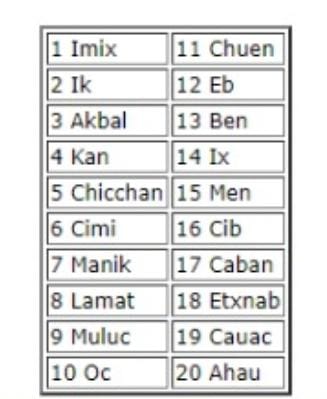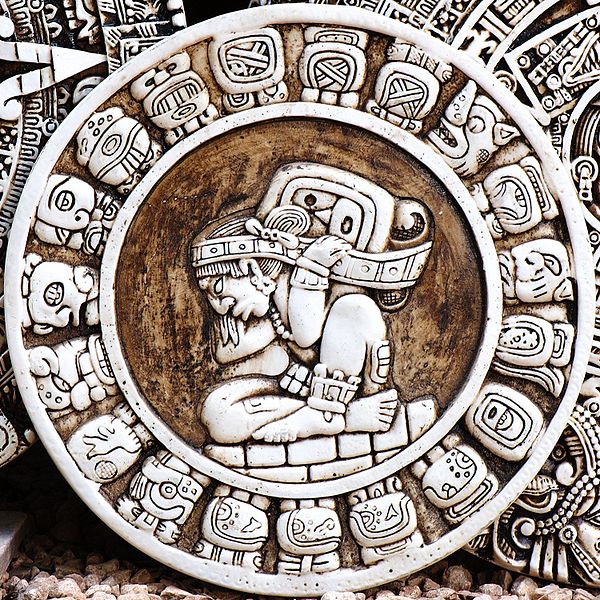The Maya had an elaborate calendrical system, no longer in use, which evolved in complete isolation from those of the old world. This system ended with the fall of the Maya civilization. Most of the remaining knowledge of this calendar was destroyed by the Spanish during the conquest. It was not until very recently, during the 1990s, that archaeologists have finally been able to fill in many of the gaps in our knowledge of Maya civilization, including the calendrical system.
The Maya were skilled mathematicians, and this shows in their calendar; besides having a concept of zero, they also had a firm grasp of modular arithmetic; they also worked extensively in base 20. However, despite their great skill at observing the heavens, their calendar has no relationship to lunar or seasonal cycles, and is only synchronized with the solar cycle year approximately. The Maya were aware of this discrepancy; they simply didn’t feel the compelling need to synchronize their calendar with the sun, unlike Old World civilizations.
The Maya used three separate calendars:
The Long Count was principally used for historical purposes, since it can define any date for millenia in the past and future.
The Haab was a civil calendar based on a year of 360 days consisting of 18 periods of 20 days. Five days were added at the end of the Haab year to approximately synchronize it with the solar year.
The Tzolkin calendar was used for ceremonial purposes, which had 20 periods of 13 days. The Tzolkin calendar went through a complete cycle every 260 days. The signficance of this cycle is unknown; it may be connected with the orbit of Venus, which has a period of 263 days.
Both the Haab and Tzolkin dates did not have a year component; however, a combined Haab and Tzolkin date, can specify a single unique day within a 52 year cycle.
There is a great deal of nonsense that has been written about the Maya long count. It was claimed (most egregiously, in a Discovery Channel TV series), that it’s end in 2012 would mark something large, and along with it a Maya apocalypse would arrived… as we are still here, it turned out to be a hoax. Once any given cycle ends, another begins, endlessly. The full long count is currently at Baktun 13 ; there are still 8 Baktuns (or about 2,758 years from now) before it turns over.
The long count

The zero day of the Maya calendar is the date given above as the ‘Mayan Epoch’. The significance of this particular date, which far exceeds any known historical horizon for Mayan civilization, is unknown. No recorded Mayan date preceeds baktun 7, and most of the historical Mayan events occurred during baktun 9 (from 435-830 C.E.).
Even longer dates with more components have been found. This includes enough additional base 20 components to write dates millions of years in the past or future, even though no such dates actually occur in the Mayan inscriptions, just contemporary dates with more digits in front of them. Imagining that kind of chronological depth to the universe is another Mayan accomplishment, similar to Hindu and Buddhist chronologies which encompass not just millenia, but billions of years of cosmic history.
Haab Date
Each Haab date consists of a one of twenty day numbers, (numbered from 0 to 19), and a ‘month’ or uinal name, of which there are 18. The uinal names are as follows:

The solar calendar or Haab has 365 days made up of 18 months of 20 days each, which adds up to 360 days. The remaining five days at the end of the year is an unlucky, dangerous time known as the Wayeb. Mayans stayed home and neglected all activities during this time to avoid disaster. In the Haab calendar, a day is represented by a number in the month, then the name of the month. There were 19 month names, plus Wayeb for the dreaded five-day month, making 20 month names.
Tzolkin Date
The Tzolkin was a cycle of 260 days, consisting of a day number from 1 to 13 and one of 20 day names. In this case both the day number and the day name are incremented each day, that is, both advance in parallel. Since 13 and 20 do not divide evenly, it is 260 days before a particular Tzolkin date repeats. There is no year component to the Tzolkin date.
This is a list of the Tzolkin day names:

The Tzolkin or sacred calendar consisted of 20 periods each with 13 days for a 260-day count. Each day had a number and a name, the numbers from 1 to 13 and 20 day names. When the 13 numbers were gone through, they began again, and the 20 day names continued. When the day names were gone through, they repeated, and the numbers continued up to 13. The cycles of 13 and 20 repeated until they came back to the first number, first name again in 260 days. The priests who kept the calendars used the Tzolkin to determine days for sowing and harvest, military triumphs, religious ceremonies and divination.
The Yucatan Times
Newsroom




1 comment
Hello